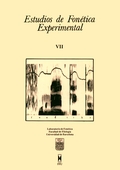Determinación del locus de las oclusivas sordas mediante ecuaciones polinómicas: primera aproximación
Abstract
In 1955, an article by Delattre, Lieberman y Cooper proposed the existence of an acoustical point that would allow the categorization of the articulation point from the next vowel of a VCV sequence. This point was called "locus". Subsequent studies carried out by Lehiste and Peterson (1961), Fant (1973), and Kewley.Port (1982)etc. in order to confirm the reality of such a parameter, concluded that it was not possible to establish such an invariant point. We have found that the locus is an intersection line, formed by the F2 values of the neighboring vowels of a VCV sequence. F2 values are approximated by means of a three-degree and two-degree polynomial (y = ax3 + bx2 + ex + d and y = ax2 + bx + e), relating time and frequency. 609 data samples from 10 speakers (6 male and 4 female) that produced VCV tokens in all vowel contexts in Spanish were analized. Three intervals were established for each articulation point. Bilabial: from 0 to 1000 Hz, alveolar: from 1500 to 2000 Hz, velar: from 1050 to 1499 Hz, palatal velar: from 2001 to 3500. Polynomic best-fits yielded the following classification rates: bilabial: 81.96%. dental: 72.06%. velar: 81.63%. We believe this to be enough to consider the reality of the Haskins locus concept, and also to suggest that polynomic equations are capable of illustrating acoustic invariance.
Downloads
Published
How to Cite
Issue
Section
License

This work is licensed under a Creative Commons Attribution-NonCommercial-NoDerivatives 4.0 International License.
All articles published online by Estudios de Fonética Experimental are licensed under Creative Commons Attribution-NonCommercial-NoDerivs 4.0 International (CC BY-NC-ND 4.0 DEED), unless otherwise noted. Estudios de Fonética Experimental is an open access journal. Estudios de Fonética Experimental is hosted by RCUB (Revistes Científiques de la Universitat de Barcelona), powered by Open Journal Systems (OJS) software. The copyright is not transferred to the journal: authors hold the copyright and publishing rights without restrictions. The author is free to use and distribute pre and post-prints versions of his/her article. However, preprint versions are regarded as a work-in-progress version used as internal communication with the authors, and we prefer to share postprint versions.




